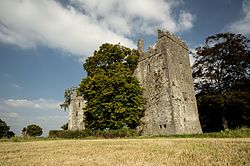Civil parish in Kilkenny, Ireland
| Burnchurch Irish: An Teampall Loiscthe | |
|---|---|
| Civil parish | |
 Burnchurch Castle, dating to the 15th or 16th century, is protected as a national monument Burnchurch Castle, dating to the 15th or 16th century, is protected as a national monument | |
 | |
| Coordinates: 52°34′41″N 7°18′07″W / 52.578°N 7.302°W / 52.578; -7.302 | |
| Country | Ireland |
| County | Kilkenny |
| Barony | Shillelogher |
| Area | |
| • Total | 13.7 km (5.3 sq mi) |
| Irish grid reference | S476474 |
Burnchurch (Irish: An Teampall Loiscthe) is a civil parish in Shillelogher, County Kilkenny, Ireland. It has an area of approximately 13.7 square kilometres (3,400 acres). Burnchurch parish contains 15 townlands, including a townland also known as Burnchurch. As of the 2011 census, Burnchurch townland had a population of 111 people. The local national (primary) school, Burnchurch National School, had an enrollment of 61 pupils as of early 2024.
History and etymology
The name of the parish derives from the townland of Burnchurch situated within the parish. The townland itself was originally named after the early Irish church founded there in the 6th century by Saint Dallán Forgaill. The original name of the church was Cill Dalláin, meaning the 'church of Dallán'. The Irish name was later corrupted into different spellings such as Kiltranyn, Kiltranen, Kyltranyn, Kiltranye and Kiltranyheyn. Kiltrani seemes to be the earliest surviving mention in 1225.
After the Norman invasion of Ireland, the parish was granted to the Fitzmaurice family. St Dallán's feast day is held on 29 January and the feast was certainly kept there in medieval times, as a document (No. 81) in the Calendar of Ormond Deeds dated 1429 states:
"Richard Horihan quit-claims to John, son of Richard Tobyn of Barlesky, all claim in all his messuages, lands and tenements in Kylamery to him and his heirs for ever. Given on the feast of St. Dallan in the 7th year of Henry VI. January 29, 1429. Seal"
Barlesky and Kylamery are corruptions of the modern townlands of Caherlesk and Killamery in the adjoining parishes of Ballytobin and Killamery. There is a holy well in the middle of Burnchurch townland named 'Tobar San Dallán' (St. Dallan's Well) in honour of the saint. The Roman Catholic Bishop of Ossory Diocese, James Phelan (1669-1695), wrote a list of patrons of the different parishes in the diocese and stated that a pattern was held at Dallán's well annually for the week commencing 31 July (probably because the weather was warmer then rather than holding it on the feast day of the saint).
According to Fr. Stephen Barron in his article Distinguished Waterford Families, published in "The Journal of the Waterford Archaeological Society" (Vol. XVII, 1914, page 54), Robert the Bruce burned Kiltranyn in 1316 and after that it was henceforth known as Burnchurch (in Irish Teampall Loiscthe or the incinerated church). In Latin it was named Ecclesia Cremata and Ecclesia Combusta. There is, however, a lack of documentary evidence for this burning and the earliest mention of the name "Burnchurch" dates from the beginning of the 15th century.
Burnchurch Castle, between Farmley and Burnchurch townlands, is a 15th or 16th-century tower house that is historically associated with the FitzGerald dynasty. It is protected as a state-owned national monument.

The nearby Church of Ireland (Anglican) church was built c. 1810. It has been disused since its closure in the mid-20th century. The adjoining cemetery contains grave markers dating from the early 18th to the mid-20th century.
Townlands
The townlands of Burnchurch civil parish include: Ballymack (Desart); Ballymack (Flood); Ballyroberts; Booly; Burnchurch; Burnchurch Viper; Coalsfarm; Farmley; Graigue Lower; Graigue Upper; Newlands; Oldtown; Paddock; Sunhill and Washers Bog.
References
- "An Teampall Loiscthe / Burnchurch". logainm.ie. Placenames Database of Ireland. Retrieved 9 August 2024.
- ^ "Civil Parish of Burnchurch, Co. Kilkenny". townlands.ie. Retrieved 9 August 2024.
- "CD158 - Kilkenny Population by Private Households, Occupied and Vacancy Rate". data.gov.ie. Central Statistics Office. Retrieved 9 August 2024.
Population Townlands Burnchurch, Burnchurch, Co. Kilkenny: 113
- "Directory Page - Burnchurch National School". gov.ie. Department of Education. 22 January 2024. Retrieved 9 August 2024.
- "The charters of the Abbey of Duiske". yumpu.com.
- "Calendar of Ormond deeds, 1172-". Dublin, Published by the Stationery Office. 11 April 1932 – via Internet Archive.
- William Healy, Healy (11 April 1893). "History and Antiquities of Kilkenny (County and City): With Illustrations ..." Egan – via Internet Archive.
- Carrigan, William (11 April 1905). The History and Antiquities of the Diocese of Ossory. Roberts Books. ISBN 9780907561002 – via Google Books.
- Journal of the Waterford & South-East of Ireland Archaeological Society (PDF). Vol. XVII. 1914. Retrieved 13 October 2020.
- "An Teampall Loiscthe/Burnchurch". Logainm.ie.
- ^ "Burnchurch Castle and Turret". heritageireland.ie. Office of Public Works. Retrieved 9 August 2024.
- ^ "Burnchurch Church, Burnchurch, Burnchurch, Kilkenny". buildingsofireland.ie. National Inventory of Architectural Heritage. Retrieved 9 August 2024.